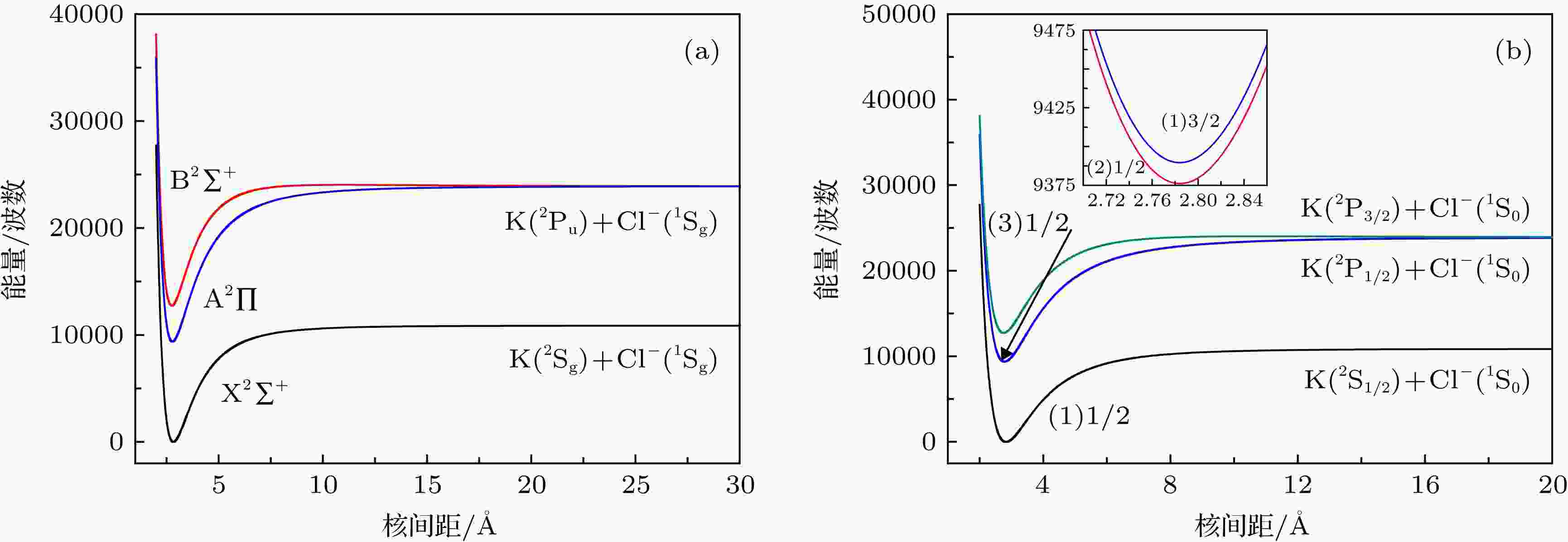全文HTML
--> --> -->中性分子的激光冷却研究已经比较广泛. 耶鲁大学的Shuman等[4]于2010年首次从实验上成功实现了SrF分子的横向冷却; 随后YO[5]和CaF[6]等分子也在实验上被证实适合激光冷却. 理论上众多分子也被预测为适合激光冷却的潜在分子, 例如MgH[7], OH[8]和CH[9]等自由基. Yzombard等[10]对

氯化钾 (KCl) 可以制取钾盐, 也可以用于石油、橡胶和电镀工业, 还是人体需要的正常电解质. Huber和Herzberg[15]归纳了KCl分子基态的平衡核间距(Re)、谐振频率(ωe)、 非谐振频率(ωeχe)和离解能(De)的实验值, 其基态具有很大的势阱, 离解能达到了4.34 eV; 1997年, Ram等[16]从实验上得到了NaCl和KCl分子的分子常数. Seth等[17]用二次组态相互作用方法(QCISD)计算得到了KCl分子的势能曲线, 并拟合得到了基态的光谱常数, 其离解能为4.028 eV, 与实验值[15]的相对误差达到了7.2%, 说明早期针对KCl体系的从头算所选取的计算方法和基组有待改进. 到目前为止, 实验上和理论上对KCl–阴离子的光谱性质和跃迁性质没有报道. 氯化物中有很多自由基适合激光冷却, 如BeCl[18], MgCl[19], CaCl[20], AlCl[21]和TlCl[22]等. 本文计算KCl–阴离子的势能曲线, 并讨论在自旋-轨道耦合效应(SOC)下激光冷却KCl–阴离子的可能性.
由于程序的限制, 在KCl–阴离子电子结构的计算过程中采用C2V群. C2V群有4个不可约表示A1, B1, B2和A2. 在CASSCF计算中, 选取8个分子轨道作为活性轨道, 包含K (4s4p)和Cl (3s3p)轨道, 9个电子占据(4, 2, 2, 0)活性空间, 可以写为CAS (9, 8), 而K (3p)轨道为双占据的闭壳层轨道, 剩余的K (1s2s2p3s)和Cl (1s2s2p)轨道为冻结轨道; 在MRCI + Q计算中考虑了核-价电子(CV)关联效应, K(3p)轨道参与CV关联计算. 也就是说有15个电子参与了电子关联计算. 最后在MRCI + Q水平下通过Breit-Pauli算符[29]考虑了SOC效应, 得到Ω态的势能曲线.
通过LEVEL 8.0程序[30]来拟合Λ-S态和Ω态的光谱常数, 并对(2)1/2, (3)1/2和(1)3/2电子态的弗兰克-康登因子 (fν′ν′′), 自发辐射速率 (Aν′ν′′)和自发辐射寿命 (τ)进行了预测.
3.1.离解极限
K和Cl原子亲合能的实验值分别为0.5015[31]和3.6127 eV[32], 故KCl–阴离子最低的两个离解极限分别为K(2Sg) + Cl–(1Sg)和K(2Pu) + Cl–(1Sg), 来源于K原子4s→4p轨道的跃迁. 本文采用MRCI + Q方法计算了KCl–阴离子最低两个离解极限对应的3个电子态的电子结构. X2Σ+态对应于最低离解通道K(2Sg) + Cl–(1Sg), A2Π和B2Σ+对应于第二离解通道K(2Pu) + Cl–(1Sg).考虑SOC效应后, A2Σ态分裂成1/2和3/2态, K(2P)原子态分裂为K(2P3/2)和K(2P1/2). KCl–阴离子Ω电子态的离解极限见表1, 可以看出分裂的两条离解极限K(2P1/2) + Cl–(1S0)和K(2P3/2) + Cl–(1S0)与最低离解极限K(2S1/2) + Cl–(1S0)的能量差分别为12997.94和13046.23 cm–1, 与K原子的2P1/2和2P3/2的实验值的相对误差仅为0.1%和0.03%, 本文计算结果与Moore的实验值[33]符合很好.
| 原子态 | Ω态 | ΔE/cm–1 | |
| 计算值 | 实验值[33] | ||
| K(2S1/2) + Cl–(1S0) | (1)1/2 | 0 | 0 |
| K(2P1/2) + Cl– (1S0) | (2)1/2 | 12997.94 | 12985.17 |
| K(2P3/2) + Cl– (1S0) | (3)1/2, (1)3/2 | 13046.23 | 13042.89 |
表1KCl–阴离子Ω电子态的离解极限
Table1.The dissociation relationship for the Ω states of KCl– anion.
2
3.2.势能曲线和光谱常数
在MRCI + Q水平下计算了KCl–阴离子最低的3个Λ-S态(X2Σ+, A2Π和B2Σ+)的势能曲线, 考虑SOC效应后, 原先的3个Λ-S态分裂成4个Ω态, 包含了3个Ω = 1/2和1个Ω = 3/2. Λ-S态和Ω态的势能曲线分别绘于图1(a)和图1(b)中. 可以看出4个Ω态都是束缚态, 而且4条曲线没有交叉现象. 图 1 KCl-阴离子的势能曲线 (a) Λ-S态; (b) Ω态
图 1 KCl-阴离子的势能曲线 (a) Λ-S态; (b) Ω态Figure1. Potential energy curves of KCl– anion: (a) Λ-S states; (b) Ω states.
4个Ω态的光谱常数列在表2中. (1)1/2对应X2Σ+态, 为KCl–阴离子的基态. (2)1/2和(1)3/2对应A2Σ态, (3)1/2对应B2Σ+态. 本文计算得到(1)1/2, (2)1/2, (1)3/2和(3)1/2态的平衡核间距Re分别为2.8290, 2.7839, 2.7836和2.7550 ?. 可以看出激发态和基态的核间距相差不大; 且两个分裂态(2)1/2和(1)3/2的光谱常数基本相同: ΔRe = 0.0003 ?, Δωe = 0.01 cm–1, ΔBe = 0 cm–1以及ΔDe = 0.0042 eV. 同时预测了A2Σ态的分裂常数ASO = 13.38 cm–1, 计算结果表明SOC效应对KCl–阴离子的光谱常数影响不大. 由于本文中离解极限能量差的计算值与实验值符合很好, 我们也相信KCl–阴离子光谱常数的结果也是可靠的.
| Ω态 | 对应的Λ-S态 | Re/? | ωe/cm–1 | Be/cm–1 | De/eV | Te/cm–1 |
| (1)1/2 | X2Σ+ | 2.8290 | 212.34 | 0.1143 | 1.3483 | 0 |
| (2)1/2 | A2Π | 2.7839 | 229.64 | 0.1180 | 1.7976 | 9375.30 |
| (1)3/2 | A2Π | 2.7836 | 229.65 | 0.1180 | 1.8018 | 9388.68 |
| (3)1/2 | B2Σ+ | 2.7550 | 235.48 | 0.1205 | 1.3865 | 12746.21 |
表2KCl– 阴离子的Ω态的光谱常数
Table2.Spectroscopic parameters for the Ω states of KCl– anion.
2
3.3.偶极矩和跃迁偶极矩
偶极矩是离子的固有性质, 反映了离子的成键性质; 同时它在激光与分子离子的相互作用中起着很重要的作用, 较大的偶极矩便于激光冷却实验中外场的操作. 图2描绘了KCl–阴离子的4个Ω态的偶极矩. 从图2中可以看出, 当核间距较大时, 4个Ω态的偶极矩都随着核间距的增加呈线性增加, 当核间距R增加至10 ?时, 4个Ω态的偶极矩都超过了20 deb. 这是由于KCl–为阴离子体系, 4个电子态的离解极限都为离子对K + Cl–. 基态(1)1/2在平衡位置Re处的偶极矩为3.079 deb, 表明该态具有离子键特点. KCl–阴离子基态的偶极矩比SrF分子基态的偶极矩略小(SrF: μ = 3.5 deb[4]); 其基态偶极矩要略大于OH–阴离子基态偶极矩(OH–: μ = 2.859 deb[11]). 可以看出激光冷却KCl–阴离子具有足够大的偶极矩. 图 2 KCl-阴离子的偶极矩
图 2 KCl-阴离子的偶极矩Figure2. Dipole moments (DMs) of KCl- anion.
为了预测KCl–阴离子的弗兰克-康登因子(FCFs)和自发辐射速率(Aν′ν″), 本文还计算了(2)1/2?(1)1/2, (1)3/2?(1)1/2, (3)1/2?(1)1/2, (3)1/2?(2)1/2和(3)1/2?(1)3/2跃迁的跃迁偶极矩, 如图3所示. 由于(3)/1/2和(1)3/2态来源于同一离解极限, 在核间距趋于无穷远时不存在原子态之间的跃迁; 而(2)/1/2和(3)1/2态来源于K(2P1/2) + Cl–(1S0)和K(2P3/2) + Cl–(1S0), (3)1/2?(2)1/2在无穷远处的跃迁源自K原子2P两个分裂态的跃迁(2P1/2)?(2P3/2), K为轻原子, 2P两个分裂态的跃迁可以忽略. 故在图3中可以看出, 在核间距约为10 ?以后, (3)1/2?(1)3/2和(3)/1/2?(2)1/2跃迁的跃迁偶极矩趋近于零. 另一方面, 当核间距R = 50 ?时, (2)1/2?(1)1/2, (1)3/2?(1)1/2, (3)1/2?(1)1/2跃迁的跃迁偶极矩都趋于7.85 D, 源自于K原子2S1/2?2P1/2, 3/2跃迁.
 图 3 KCl–阴离子的跃迁偶极矩
图 3 KCl–阴离子的跃迁偶极矩Figure3. Transition dipole moments (TDMs) of KCl– anion
2
3.4.激光冷却方案
在实施激光冷却KCl–阴离子的过程中, 可以考虑选择(2)1/2?(1)1/2和(1)3/2?(1)1/2直接跃迁以及(3)1/2?(1)1/2三电子能级跃迁两种方案来构造能级系统. 候选分子离子是否适合激光冷却主要取决于FCFs是否具有高对角化分布. 本文计算得到了(2)1/2?(1)1/2, (1)3/2?(1)1/2, (3)1/2?(1)1/2, (3)1/2?(2)1/2和(3)1/2?(1)3/2跃迁的跃迁性质, 表3和表4中列出了以上5种跃迁的FCFs (fν′ν″), 自发辐射速率Aν′ν″和自发辐射寿命τ.| 跃迁 | ν′′ | 0 | 1 | 2 | 3 | |
| (2)1/2?(1)1/2 | Aν′ν′′/s–1 | 1.9384(7)a | 2.3044(6) | 1.7867(5) | 1.1906(4) | |
| ν′ = 0 | fν′ν′′ | 0.8816 | 0.1090 | 0.0088 | 0.0006 | |
| τ/ns | 45.7 | |||||
| Aν′ν′′/s–1 | 2.5793(6) | 1.4757(7) | 4.0633(6) | 5.0295(5) | ||
| ν′ = 1 | fν′ν′′ | 0.1128 | 0.6687 | 0.1914 | 0.0246 | |
| τ/ns | 45.5 | |||||
| Aν′ν′′/s–1 | 1.3368(5) | 4.7122(6) | 1.0816(7) | 5.3057(6) | ||
| ν′ = 2 | fν′ν′′ | 0.0056 | 0.2052 | 0.4883 | 0.2490 | |
| τ/ns | 45.4 | |||||
| (1)3/2?(1)1/2 | Aν′ν′′/s–1 | 1.9451(7) | 2.3276(6) | 1.8184(5) | 1.2242(4) | |
| ν′ = 0 | fν′ν′′ | 0.8808 | 0.1096 | 0.0089 | 0.0006 | |
| τ/ns | 45.5 | |||||
| Aν′ν′′/s–1 | 2.6063(6) | 1.4777(7) | 5.1089(5) | 4.7631(4) | ||
| ν′ = 1 | fν′ν′′ | 0.1134 | 0.6668 | 0.1924 | 0.0249 | |
| τ/ns | 45.4 | |||||
| Aν′ν′′/s–1 | 1.3578(5) | 4.7578(6) | 1.0803(7) | 5.3483(6) | ||
| ν′ = 2 | fν′ν′′ | 0.0057 | 0.2063 | 0.4857 | 0.2499 | |
| τ/ns | 45.2 | |||||
| 注: a1.9384(7)表示1.9384 × 107. | ||||||
表3(2)1/2?(1)1/2和(1)3/2?(1)1/2跃迁的FCFs, Aν′ν′′和τ
Table3.FCFs, spontaneous emission rates Aν′ν′′ and spontaneous radiative lifetime τ for the (2)1/2?(1)1/2 and (1)3/2?(1)1/2 transitions.
| 跃迁 | f00 | A0/s–1 | τ0/s |
| (3)1/2?(1)1/2 | 0.7122 | 2.6535(7) | 3.77(–8) |
| (3)1/2?(2)1/2 | 0.9484 | 2.3716(5) | 4.22(–6) |
| (3)1/2?(1)3/2 | 0.9490 | 2.3435(5) | 4.27(–6) |
| 注: a1.9384(7)表示1.9384 × 107. | |||
表4(3)1/2?(1)1/2, (3)1/2?(2)1/2和(3)1/2?(1)3/2跃迁的FCF, 总辐射速率A0和辐射寿命
Table4.FCFs, total emission rates A0 and τ for the (3)1/2?(1)1/2, (3)1/2?(2)1/2 and (3)1/2?(1)3/2 transitions.
3
3.4.1.直接跃迁
从表3中得到, (2)1/2?(1)1/2和(1)3/2?(1)1/2跃迁都具有高对角分布的f00, 分别为0.8816和0.8808, 比NH+离子12Π?12Σ+跃迁的FCF值要大(f00 = 0.821)[13], 且对于两种跃迁f00, f01和f02之和基本等于1, 保证了两种跃迁的准闭合循环, 满足了激光冷却的第一个条件; 此外(2)1/2?(1)1/2和(1)3/2?(1)1/2跃迁的总辐射速率分别为2.1880 × 107和2.1974 × 107 s–1, 即(2)1/2和(1)3/2激发态的自发辐射寿命为45.7和45.5 ns, 可以保证循环跃迁的快速进行.在此基础上构建了(2)1/2?(1)1/2和(1)3/2?(1)1/2准闭合循环跃迁系统来对KCl–阴离子进行激光冷却. 冷却方案见图4(a)和图4(b), 图中的实线表示驱动激光, 虚线表示自发辐射. 驱动(2)1/2?(1)1/2准闭合循环跃迁需要选用主激光波长λ00 = 1065.77 nm, 增加两束抽运激光来增强激光冷却的效果, 波长分别为λ10 = 1090.13 nm和λ21 = 1087.76 nm; 同样驱动(1)3/2?(1)1/2准闭合循环跃迁需要选用一束主激光和两束抽运激光, 波长分别为λ00 = 1064.24 nm, λ10 = 1088.54 nm和λ21 = 1086.17 nm. 驱动KCl–阴离子的两种跃迁所需的激光波长都在深红外区域. 同时预测了激光驱动(2)1/2?(1)1/2和(1)3/2?(1)1/2能级跃迁的散射光子数目, 当加入了两束激光λ00和λ10时, 理论上能散射光子数目为Nscat = 1/f03+ ≈ 1500, 再加上λ21可以散射更多数目的光子.
 图 4 激光冷却KCl–阴离子的方案 (a) (2)1/2?(1)1/2准闭合循环跃迁系统; (b) (1)3/2?(1)1/2准闭合循环跃迁系统
图 4 激光冷却KCl–阴离子的方案 (a) (2)1/2?(1)1/2准闭合循环跃迁系统; (b) (1)3/2?(1)1/2准闭合循环跃迁系统Figure4. Proposed laser cooling scheme of KCl– anion: (a) Using (2)1/2?(1)1/2 transition; (b) using (1)3/2?(1)1/2 transition.
3
3.4.2.三电子能级跃迁
从表4中可以看到, (3)1/2?(1)1/2跃迁也具有较大的FCF (f00 = 0.7122)和很小的自发辐射寿命 (τ = 0.377 μs), 但在循环跃迁中存在中间态(2)1/2和(1)3/2, 能否适合激光冷却就需要考虑中间态的存在是否影响循环跃迁的闭合性. 本文通过振动分支损失比来分析跃迁的闭合性. 振动分支损失比可以表示为 η1 = γ1/γΣ或η2 = γ2/γΣ, 在本文中γ1, γ2和γΣ分别表示(3)1/2?(2)1/2, (3)1/2?(1)3/2和(3)1/2?(1)1/2跃迁的总自发辐射速率, 通过表4可以得到η1 = 8.94 × 10–3和η2 = 8.83 × 10–3. 实验上实现了YO分子的激光冷却[5], YO分子中间态的分支损失比小于4 × 10–4, 本文计算得到的分支损失比约为YO分子的20倍. 由于激光驱动(3)1/2?(1)1/2能级跃迁的散射光子数目只有约150个, 而中间态的存在还会损失部分散射光子. 所以我们认为不需要考虑构建三电子能级跃迁来激光冷却KCl–阴离子.3
3.4.3.最大加速度, 最小减速距离, 多普勒温度和反冲温度
(2)1/2?(1)1/2和(1)3/2?(1)1/2跃迁产生的最大加速度可以由


为了评估冷却效果, 本文预测了激光冷却KCl–阴离子的多普勒温度以及反冲温度. 多普勒温度可以由下面公式计算:


计算得到(2)1/2?(1)1/2和(1)3/2?(1)1/2跃迁为直接跃迁, 具有高对角分布的FCF, 分别为0.8816和0.8808; 同时(2)1/2和(1)3/2激发态有很短的自发辐射寿命, 分别为45.7和45.5 ns. 本文给出了(2)1/2?(1)1/2和(1)3/2?(1)1/2准闭合能级循环跃迁进行激光冷却KCl–阴离子的方案. 分别选取3束激光驱动(2)1/2?(1)1/2和(2)1/2?(1)1/2跃迁, 主激光波长分别为1065.77和1064.24 nm. 最后预测了两种方案进行激光冷却KCl–阴离子的多普勒温度和反冲温度. 反冲温度约为多普勒温度的2.7 × 10–3倍.
